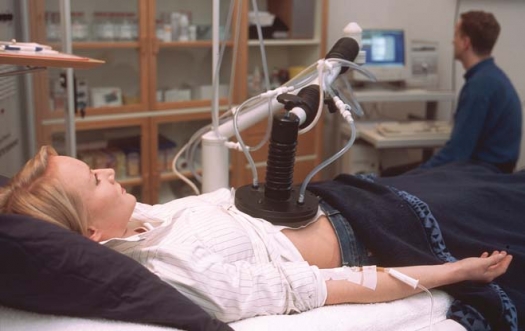Research Report
- Location: Europe
- Website: Oncotherm
OncothermiaTreatment.jpg

Image by Dr. med Peter Wolf, ©2012 / Wikimedia Commons
Oncothermia has become one of the leading Hyperthermia-therapies in Europe.
Oncothermia was developed twenty years ago in the Budapest Science University and as a spin-off company has been active since then. It has the largest number of installations of hyperthermia for oncology in Europe, with more than 100,000 treatments annually.
Method
Oncothermia1 has cell-selective focus on the tumor and it is free from dangerous hot spots. The main characteristics of the method are its self-selective behavior and its apoptosis oriented cell-killing mechanism. Both the features are proven in detailed theoretical2 and experimental processes.
These features are based on the definite larger conductivity of the malignant tissues. Numerous innovative techniques were developed to avoid side effects and improve the efficacy of the cellular distortion:
- extracellularRF-conduction3 forcing extra ionic currents to damage the cell-membrane
- modulation (fractal-physiology) applied to enhance the membrane destruction
- new coupling used to maximize the energy focus.
Results
Numerous laboratory and preclinical experiments have established the clinical applications. In the preclinical studies the exceptionally high efficacy of the treatment selection and cell-disruption is shown4.
Oncothermia has very positive retrospective data. On brain-gliomas,5, 6, 7, (presented even on ASCO8) on pancreas9, on liver10 and on osteosarcoma11. Many other tumor studies have been presented at various conferences showing the effect of the method on colorectal, lung, pancreas, brain, stomach, esophagus, kidney, breast, prostate, and liver primary and metastatic tumors.
Conclusion
Oncothermia, with its modulated and carefully filtered frequency delivery, is able to destroy selectively the malignant cells12, 13. Precise modulation-enhanced energy focusing (which is proven on animals) is the safeguard of the efficacy and the safety of the method. This is proven not only in the theories and laboratory experiments, but is also testified by twenty years of successful medical practice.
Contact information:
Tel: +36 (23) 555510
Fax: +36 (23) 555515
E-mail: oncotherm@oncotherm.org
References
1 Szasz A, Szasz O, Szasz N: Physical background and technical realizations of hyperthermia, in: Hyperthermia in cancer treatment: A primer, Baronzio GF, Hager ED (Eds), Springer Science, New York, 2006 Ch.3, pp.27-59
2 Szasz A, Vincze G, Szasz O, Szasz N: An energy-analysis of extracellular hyperthermia, Electromagnetic Biology and Medicine 22:103-115, 2003
3 Andocs G, Renner H, Balogh L, Folnyad L, Jakab Cs, Szasz A: Strong synergy of heat and the modulated electromagnetic field at HT29 xenograft study in nude mice, submitted to Strahlentherapie und Onkologie, 2008
4 Szasz A, Vincze G, Szasz O, Szasz N: An energy-analysis of extracellular hyperthermia, Electromagnetic Biology and Medicine 22:103-115, 2003
5 Szasz A, Vincze G: Dose concept of oncological hyperthermia: heat equation considering the cell destruction, Journal of Cancer Research and Therapeutics, 2:171-181, 2006
6 Andocs G, Szasz O, Renner H, Patonay L, Balogh L, Fonyad L, Jakab Cs, Szasz A: Synergy of temperature-dependent and field-dependent effects at HT29 xenograft study in nude mice, Electromagnetic Biology and Medicine, (submitted, 2008)
7 Andocs G, Renner H, Balogh L, Fonyad L, Jakab Cs, Szasz A: Strong synergy of heat and modulated electromagnetic field in tumor cell killing, Strahlentherapie und Onkologie, (submitted, 2008)
9http://link.springer.com/10.1007%2Fs002490100143
10https://www.tandfonline.com/page/looking-for-something
12www.gimt-online.de/uploads/media/Therapieergebnisse_Giloma_Studie_01.pdf
13https://www.ncbi.nlm.nih.gov/sites/entrez?cmd=Retrieve&db=PubMed&list_uids=17203754&dopt=Citation

